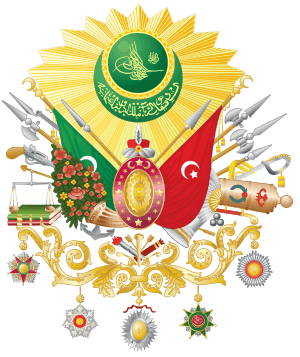Dilfirib Kadın
Dilfirib Kadın (Ottoman Turkish: دل فریب قادین; c. 1890 – c. 1952) was the fifth wife of Sultan Mehmed V of the Ottoman Empire.[1]
| Dilfirib Kadın | |||||
|---|---|---|---|---|---|
| Born | c. 1890 Istanbul, Ottoman Empire | ||||
| Died | c. 1952 (aged 61–62) Erenköy, Istanbul, Turkey | ||||
| Burial | |||||
| Spouse | |||||
| |||||
| House | Ottoman (by marriage) | ||||
| Religion | Sunni Islam | ||||
Early life
Of Circassian origin, Dilfirib was born in 1890 in Istanbul.[2][3]
Marriage
Dilfirib married Mehmed in 1907 in the Veliahd Palace,[2] when Mehmed was sixty-three years old, and Dilfirib was seventeen. Dilfirib remained childless.[3] On 27 April 1909, after Mehmed's accession to the throne,[4] she was given the title of "Baş Ikbal". In October 1909, she was given the title of "Dördüncü Kadın".[5]
Safiye Ünüvar, a teacher at the Palace School, who met her in 1915, described her being young and well educated.[6][7]
On 30 May 1918, Nazikeda met with the Empress Zita of Bourbon-Parma in the harem of Yıldız Palace, when the latter visited Istanbul with her husband Emperor Charles I of Austria. With her beauty, she won the Empress's appreciation.[8]
Dilfirib and Nazperver Kadın, Mehmed's fourth wife were with him,[9][10] when he died on 3 July 1918.[11]
Last years and death
After Sultan Mehmed’s death in 1918, she remained in the Dolmabahçe Palace. When the imperial family went into exile in 1924, she moved in her villa located in Erenköy, where she died in 1952.[1][3]
Honours

References
- Uluçay 2011, p. 261.
- Açba 2007, p. 176.
- Brookes 2010, p. 280.
- Faroqhi, Suraiya (2008). The Cambridge History of Turkey. Cambridge University Press. p. 79. ISBN 978-0-521-62096-3.
- Toplumsal tarih, Issues 109-114. Türkiye Ekonomik ve Toplumsal Tarih Vakfı. 2003.
- Brookes 2010, p. 210.
- Sakaoğlu 2008, p. 704.
- Açba, Leyla (2004). Bir Çerkes prensesinin harem hatıraları. L & M. p. 58. ISBN 978-9-756-49131-7.
- Brookes 2010, p. 262.
- Toplumsal tarih, Issues 109-114. Türkiye Ekonomik ve Toplumsal Tarih Vakfı. 2003.
- Tucker, Spencer C. (October 28, 2014). World War I: The Definitive Encyclopedia and Document Collection [5 volumes]: The Definitive Encyclopedia and Document Collection. ABC-CLIO. p. 1071. ISBN 978-1-851-09965-8.
Sources
- Uluçay, M. Çağatay (2011). Padişahların kadınları ve kızları. Ötüken. ISBN 978-9-754-37840-5.
- Açba, Harun (2007). Kadın efendiler: 1839-1924. Profil. ISBN 978-9-759-96109-1.
- Sakaoğlu, Necdet (2008). Bu Mülkün Kadın Sultanları: Vâlide Sultanlar, Hâtunlar, Hasekiler, Kandınefendiler, Sultanefendiler. Oğlak Yayıncılık. ISBN 978-6-051-71079-2.
- The Concubine, the Princess, and the Teacher: Voices from the Ottoman Harem. University of Texas Press. 2010. ISBN 978-0-292-78335-5.
